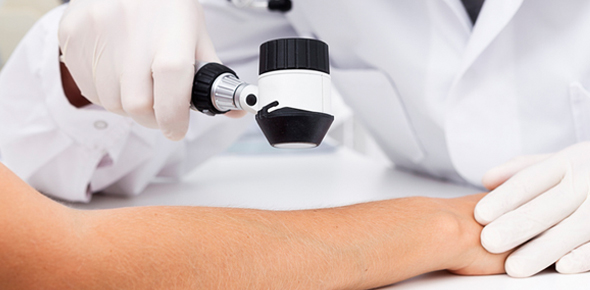Do you know your ABCs?

The American Cancer Society’s estimates that approximately 11% of the population that is diagnosed with melanoma are expected to die this year. The rate of melanoma has been rising over the last 30 years. In fact, it’s one of the most common cancers in young adults, especially young women. Knowing your ABCs could save your life.
Pigmented areas are commonly seen on the body and sometimes on the feet. These may be normal birthmarks or moles or may be a form of skin cancer. The three most common forms of skin cancer on the foot are: Basal Cell Carcinoma, Squamous Cell Carcinoma and Malignant Melanoma.
Basal Cell Carcinoma (BCC) is typically found on sun exposed areas. It rarely spreads, rarely metastasizes and rarely causes death. Treatment may consist of cryosurgery, laser, radiation, topical creams or excision.
Squamous Cell Carcinoma (SCC) is also usually found on sun exposed areas. They appear as thick, red scaly patch or may look like a bleeding ulcer. Treatment may consist of cryosurgery, laser, radiation, topical creams or excision.
Malignant Melanoma is the deadliest of all the skin cancers and is nicknamed ‘’the great masquerader” since it may resemble a birthmark, mole, wart or even bruise or blood blister. The cancer spreads as it grows beneath the surface. The characteristics to look for are the ABCDEs.
See your doctor if any of your moles or pigmented spots exhibit:

A = Asymmetry
One half is unlike the other half.

B = Border
An irregular, scalloped or poorly defined border.

C = Color
Is varied from one area to another; has shades of tan, brown or black, or is sometimes white, red, or blue.

D = Diameter
Melanomas are usually greater than 6mm (the size of a pencil eraser) when diagnosed, but they can be smaller.

E = Evolving
A mole or skin lesion that looks different from the rest or is changing in size, shape or color.
These three lesions can be diagnosed in the office with a simple, painless punch biopsy.
Now that you know your ABCs and use the following as a guide in prevention:
- Seek the shade, especially between 10 AM and 4 PM.
- Do not burn.
- Avoid tanning and never use UV tanning beds.
- Cover up with clothing, including a broad-brimmed hat and UV-blocking sunglasses.
- Use a broad spectrum (UVA/UVB) sunscreen with an SPF of 15 or higher every day. For extended outdoor activity, use a water-resistant, broad spectrum (UVA/UVB) sunscreen with an SPF of 30 or higher.
- Apply 1 ounce (2 tablespoons) of sunscreen to your entire body 30 minutes before going outside. Reapply every two hours or immediately after swimming or excessive sweating.
- Keep newborns out of the sun. Sunscreens should be used on babies over the age of six months.
